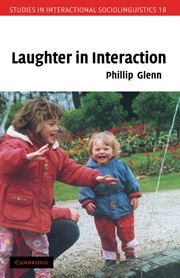Book contents
- Frontmatter
- Contents
- List of figures and tables
- Acknowledgments
- Transcription symbols
- Introduction
- 1 Towards a social interactional approach to laughter
- 2 Conversation analysis and the study of laughter
- 3 Laughing together
- 4 Who laughs first
- 5 Laughing at and laughing with: negotiating participant alignments
- 6 Laughing along, resisting: constituting relationship and identity
- 7 Closing remarks
- Notes
- References
- Index
6 - Laughing along, resisting: constituting relationship and identity
Published online by Cambridge University Press: 08 August 2009
- Frontmatter
- Contents
- List of figures and tables
- Acknowledgments
- Transcription symbols
- Introduction
- 1 Towards a social interactional approach to laughter
- 2 Conversation analysis and the study of laughter
- 3 Laughing together
- 4 Who laughs first
- 5 Laughing at and laughing with: negotiating participant alignments
- 6 Laughing along, resisting: constituting relationship and identity
- 7 Closing remarks
- Notes
- References
- Index
Summary
Earlier chapters have shown the ways laughs are organized relative to speech and activity. In this chapter the focus moves to two distinct but connected sequential activities, and how these activities help people accomplish in-the-moment relationship and identity. One activity is laughing along. In response to teases and improprieties, laughter shows willingness to go along but (by itself) stops short of outright affiliation with what is going on. However, laughing along may well lead the recipient to being implicated further in activities in which that person is the butt of a tease or is invited to participate in potentially rude and offensive talk. This leads to the second sequential activity of interest in this chapter, resisting. Recipient laughter can show appreciation only, or even reluctance, rather than affiliation with what the laughable is doing. Laughing then offers a response somewhere between outright rejection and outright co-implication in potentially problematic talk.
This consideration of laughing along and resisting has its roots in two previous articles, and detailed explication of their arguments will help lay groundwork for the rest of the chapter. Drew (1987) shows how laughter occurs as a midpoint in a range of responses by the victims of teases. Similarly, Jefferson, Sacks, and Schegloff (1987) characterize laughter as occupying a midplace on a continuum of responses to improprieties and contributing to expanded sequences culminating in displays of intimacy.
- Type
- Chapter
- Information
- Laughter in Interaction , pp. 122 - 161Publisher: Cambridge University PressPrint publication year: 2003



